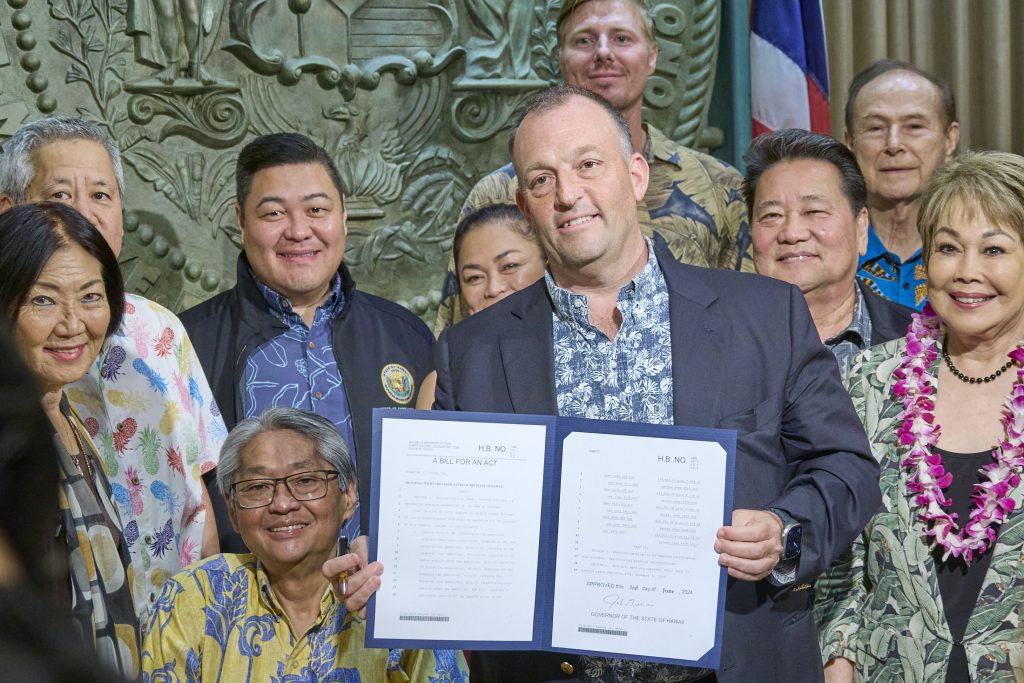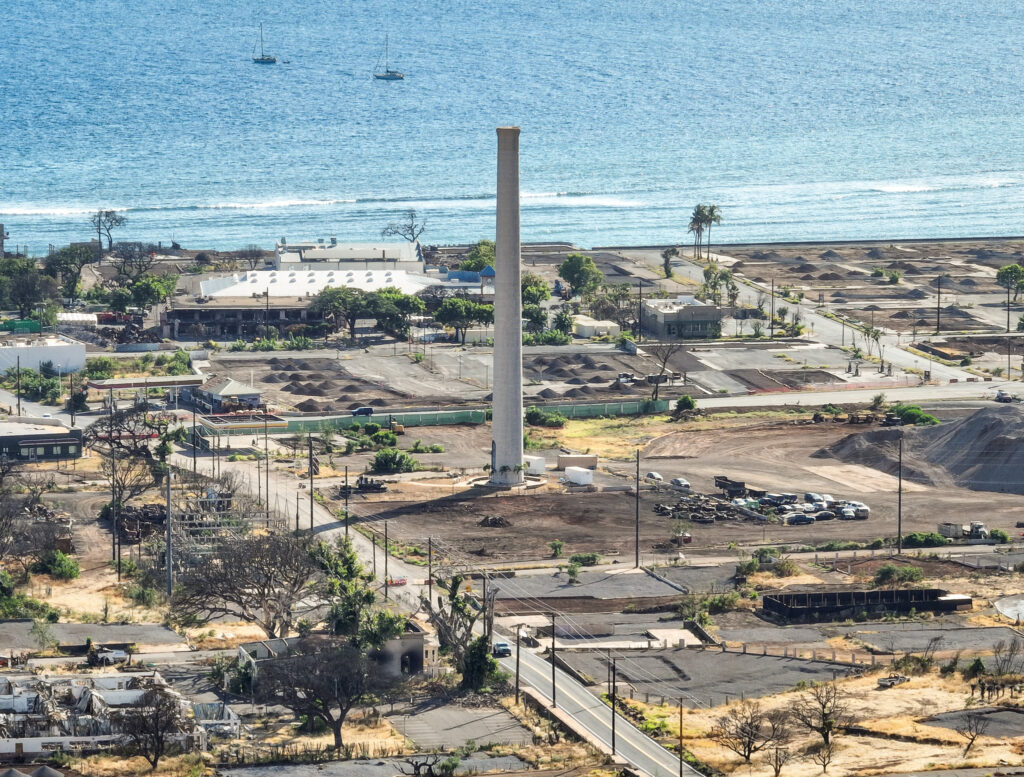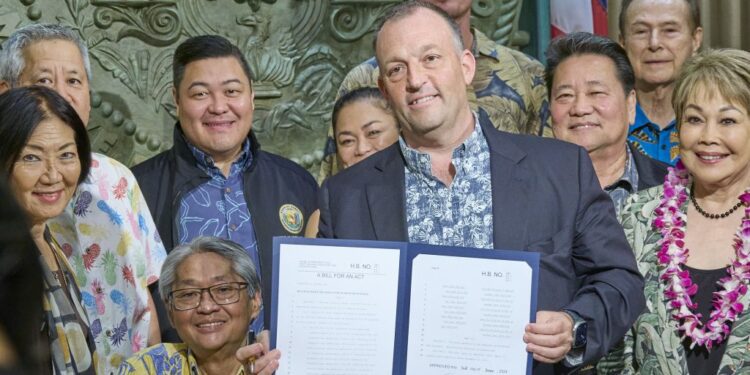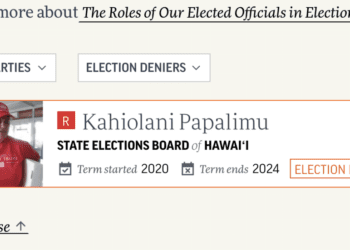Hawaii state government is deep into a remarkable surge in spending, with more to come. But there is no sign state tax collections are growing at a particularly rapid clip, which raises questions about how Gov. Josh Green’s administration is going to pay the bills.
Green offered an upbeat assessment of the situation in an interview last week, saying the state is not headed for a budget crisis when the Legislature reconvenes in January. However, the raw numbers are eye-catching.
Pandemic hazard back pay for public employees will cost more than $450 million. The state’s share of the newly proposed Maui wildfire settlement is nearly $873 million, which will be in addition to $800 million the state committed earlier this year to the wildfire recovery effort.
Meanwhile, the historic income tax cut signed into law by Green last spring will cost the state general fund about $40 million in lost tax collections this fiscal year. The revenue loss from the tax cut will balloon to nearly $570 million the following year.

 Gov. Josh Green poses for pictures in a packed ceremonial office in the State Capitol building after signing bills to reduce state income taxes and eliminate the excise tax on medical services reimbursed by Medicare, Medicaid and TRICARE. Those tax cuts and costs related to the Lahaina wildfire recovery effort are raising concerns about the state budget. (David Croxford/Civil Beat/2024)
Gov. Josh Green poses for pictures in a packed ceremonial office in the State Capitol building after signing bills to reduce state income taxes and eliminate the excise tax on medical services reimbursed by Medicare, Medicaid and TRICARE. Those tax cuts and costs related to the Lahaina wildfire recovery effort are raising concerns about the state budget. (David Croxford/Civil Beat/2024)
This is all happening just as contracts for almost all of the public worker unions will expire next year, which likely will require more money to pay for public employee raises or benefits.
“It could be tight,” Green said of the budget scenario heading into next year.
Budget Proposal Looms
But even with all of that money going out the door, Green predicted the state will not need to dip into its emergency and budget reserve fund to balance the budget. That fund — better known as the rainy day fund — holds a record $1.5 billion.
The administration will submit a proposed two-year state budget to the Legislature in December, and Green said he won’t be asking the Legislature for authority to launch any large or dramatic new government programs during the next session.
Still, some observers are concerned the state may find itself in a dire financial situation, especially if the tourism industry hits hard times in the years ahead.
“We have responsibilities, and we live up to them.”
Gov. Josh Green
Paul Brewbaker, a longtime Hawaii economist and principal of TZ Economics, said history shows even large state budget surpluses can rapidly disappear when the economy slumps, forcing the government to cut services or even impose public worker furloughs.
“You know there are states and municipalities that from time to time get caught off guard,” he said. “It seems like we’re sort of one bad climate change rogue event from catastrophe.”
Economic growth in Hawaii has lagged behind almost every other state during the past six years, Brewbaker said, and the state’s shrinking population is expected to continue to drag on the local economy.
“I hope that Gov. Green’s optimism is rewarded,” Brewbaker said. “I would be more optimistic if I could actually see the Hawaii economy keeping up with its peers across the country.”
Green is advocating for some version of his proposed fee on tourists, which has so far been rejected by legislators, to help finance steps that Hawaii must take to cope with the impacts of climate change, but said he does not need that fee to balance the budget.
He said his administration recently lapsed more than $400 million in unspent funds from last year, which will help the bottom line this year. The most recent state financial plan made public last December had anticipated the state would lapse only $80 million in unspent state funds each year.
Green also said his administration will cut funding for government jobs that have sat vacant for five years or more, which will free up more cash for other uses. Those positions are “not functional” anyway, so services to the public will not be cut when funding is stripped from those vacant positions, Green said.
Helping Maui
The $873 million price tag for the state’s share of the proposed $4 billion wildfire settlement sounds huge, but Green said the state will be able to spread the payments on that settlement over three years if it wins final approval in court.
That settlement is well worth the cost because the state will face “enormous” liability in connection with the Lahaina fire unless lawsuits over the disaster can be settled before going to trial, Green said. The total cost of the recovery for Lahaina will be over $13 billion, he said.

 The state faces an $873 million price tag as part of the proposed $4 billion Maui wildfire settlement. The historic town of Lahaina is beginning to rebuild after being devastated in the Aug. 8, 2023, blaze. (Nathan Eagle/Civil Beat/2024)
The state faces an $873 million price tag as part of the proposed $4 billion Maui wildfire settlement. The historic town of Lahaina is beginning to rebuild after being devastated in the Aug. 8, 2023, blaze. (Nathan Eagle/Civil Beat/2024)
The state will use $200 million in insurance proceeds to help pay the first installment on the settlement, Green said, referring to money being paid by private insurers to settle claims for state facilities that were damaged or destroyed in the Aug. 8, 2023, Lahaina wildfire.
Green also cited the $916 million Circuit Court judgment for the state against the makers of Plavix that was announced last spring as a source of extra money. The pharmaceutical companies appealed the award, but Green is optimistic the state will eventually prevail.
“I, like you, want to see the check before I count it, OK?” Green said. “But it’s not like we are in a bad position here, we’ve actually beaten them twice (in court), and that money is probably going to come to the state of Hawaii plus interest.”
“If this thing gets resolved, that of course is a lot of resource that can be earmarked for things like — even though we’ve already put it in the budget — hazard pay settlements and so on, with very little concern. Because I worry about money, too, just like any governor would,” he said.
Projecting Surplus
Green said his administration is projecting a general fund budget surplus of $703 million at the end of this fiscal year. Lawmakers and others often pay close attention to that number because the state must be able to show it has an adequate surplus or reserves to maintain its credit rating.
That $703 million would be a fairly modest surplus considering the state has been spending upward of $10 billion annually in recent years. Flush with federal Covid relief funding, the state carried record surpluses of more than $2 billion on its books at the end of fiscal years 2022 and 2023.
Total general fund state tax collections last fiscal year were $9.56 billion, and the state Council on Revenues predicted in May that collections would grow by a respectable 4.8% in the fiscal year that began July 1. The council meets Thursday to update that projection based on the latest economic data.
Brewbaker, who previously sat on the Council on Revenues, said he is concerned travel to Hawaii may suddenly slump if there is an economic slowdown on the mainland.
He recalled the events that played out in Hawaii following the Great Recession, which culminated in 2009, as tourism was slow to recover and the state budget surplus quickly evaporated. The state was forced to impose deep budget cuts in the years that followed.
Green said his administration is prepared to meet any budget challenges that may come up.
“Of course we’ll ask the Legislature to make sure that we can meet our core responsibilities, which is education, health care, rebuilding the community of Lahaina, and so on — those are core things — without having to make other cuts,” he said. “We have responsibilities, and we live up to them.”

Sign up for our FREE morning newsletter and face each day more informed.
Sign Up
Sorry. That’s an invalid e-mail.
Thanks! We’ll send you a confirmation e-mail shortly.
Source link : http://www.bing.com/news/apiclick.aspx?ref=FexRss&aid=&tid=66d7583b6a774880860c06102e1c3483&url=https%3A%2F%2Fwww.civilbeat.org%2F2024%2F09%2Fgovernor-hawaii-can-pay-the-bills-for-maui-fire-recovery-hazard-pay-and-more%2F&c=16906538293950147428&mkt=en-us
Author :
Publish date : 2024-09-02 23:01:00
Copyright for syndicated content belongs to the linked Source.






